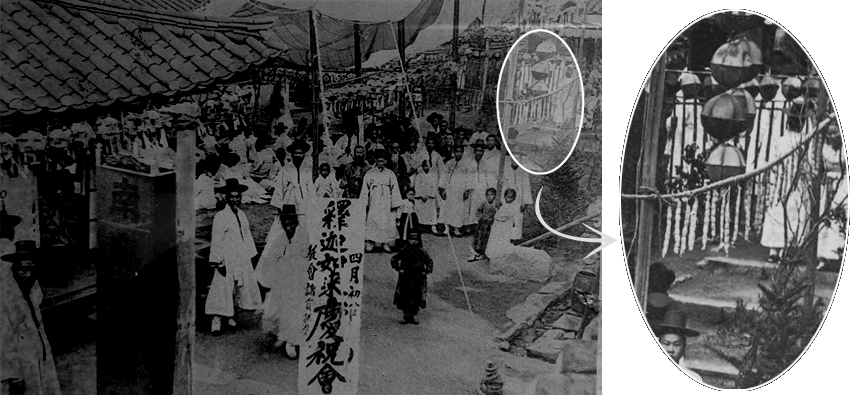낙화(落火)는 오랜 옛날부터 사찰(寺刹)에서 부정 (不淨)하고 삿된 기운을 제거하고 안전을 기원하며, 숙세(宿世)의 악업(惡業)을 정화(淨化)하던 소재구복 (消災求福) 의식이었다. 조선시대 동국세시기(東國歲時記)와 일제 강점기에 간행된 해동죽지(海東竹枝)에 사월 초파일 민속놀이로 낙화(落火)가 기록되어 있다.

이런 낙화(落火)는 민간으로 흘러 나가 벽사진경(辟邪進慶)의 의미를 담은 정월 대보름 액막이 의례로 바뀌게 된다.
민간으로 유입되어 액막이 의례가 되었던 낙화(落火)는 조선 후기에 다시 한 번 성격이 바뀌어 불꽃이 떨어지는 것을 보고 즐기는 유희(遊戲)적 성격의 낙화놀이(落火戲)로 정착된다.
조선 후기까지 사월 초파일(부처님오신날)의 대표적 민속놀이로 전래되어 오다가 일제 강점기를 거치며 단절의 위기에 처하기도 하였으나 다행히 영평사 환성스님에 의해 계승되어 현재에 이르고있다.
화약을 종이에 싸서 새끼줄에 매어 위로 올리면 승기전(乘機箭)처럼 불줄기가 밑으로 흩어지는데 마치 비오는 듯하다.
- 동국세시기
옛 풍속에 사월 팔일 숯가루를 넣은 주머니 수천 개를 숲 사이에 달아 놓고 불을 붙이면 눈과 같이 펑펑 쏟아진다. 이것을 "줄불" 이라고 한다.
- 해동죽지
영평사 소장본 『오대진언집』 공란에 수기된 낙화법이 불교의례의 형식을 갖추고 있어 주목하였다. 그리고 1920년대 개성지역을 촬영한 사진 제목 관등(觀燈)을 통하여, 낙화법의 기원과 형성과정을 분석하였다.
그 결과, 수기된 낙화법의 절차는 수구즉득다라니(隨求卽得陀羅尼)를 염송하는 법으로, 소의경전을 갖추고 소재도량(消災道場)을 목적으로 한 것임을 알았다. 소의경전은『佛說金剛頂瑜伽最勝秘密成佛隨求卽得神變加持成就陀羅尼儀軌』와 『普遍光明清淨 熾盛如意寶印心無能勝大明王大隨求陀羅尼經』으로 하며, 다라니는 普遍焰滿清淨熾盛 思惟寶印心無能勝總持大隨求陀羅尼(일명 수구즉득다라니)이다.
낙화법은 다음과 같은 변화과정 속에서 형성되었다. 먼저 연등(燃燈)과 낙화(洛火)를동일한 범주에서 다루지 않고, 등(燈)과 화(火)를 분리하여 기원과 개념을 밝혔다. 등은수행처를 밝혀 수행을 돕는 상징이며, 화는 대신변일(大神變日, 정월 15일)의 소재도량이다. 등(燈)과 화(火)는 중국에서 고대 세시풍습인 폭죽·상원일·납제일 등과 결합하여연등회를 탄생시킨다. 국가나 왕실이 주관하는 상원연등회는 크게 연등과 불꽃놀이(화약사용)로 구성한다. 이 행사는 신라로 유입되고, 고려로 이어진다. 고려무신기를 지나며, 상원연등회에서 연등과 불꽃놀이의 주체는 왕실에서 사찰로 변화하기 시작한다. 조선왕실의 불꽃놀이에 대한 인식은 재난·재해의 퇴치와 치병이며 왕실의 안녕과 복을 비는것으로 소재도량의 설행을 의미했다. 화약 재료인 염초(焰硝, 질산칼륨, KNO₃)와 황(S) 의 수급문제가 발생하자, 화약 재료 중에 남아있는 숯 만을 사용한 낙화법을 고안하게된다. 종이와 숯의 수급이 용이했던 사찰에서는 숯을 이용한 불꽃놀이에 불교의궤를 접합한 불교의례로 발전시킨다. 이 낙화법은 불교에서 화(火)의 개념에 담겨있던 재난을물리치고 병을 치료하는 의미를 담아냄은 물론 밀교의 삼밀(三密)수행을 잘 담아내고있다.
때문에 낙화법은 놀이가 아닌 불교수행법으로 의의가 있고, 한국전통문화의 한 종류가 되기에 충분한 것이다.
View in English
First of all, the origin and concept were revealed by separating the lamp and fire, without dealing with the lotus lamp and falling fire in the same category. Lamp is a symbol that helps practice by lighting where to practice, and fire is Mahā-vikurvaṇa day (January 15) of Disaster Prevention Ceremonies.
Lamp and fires are combined with firecrackers, Sangwon Day and Napjae Day, which are ancient customs in China, to create a lantern festival. The Sangwon Yeondeunghoe Festival, organized by the state or the royal family, is largely composed of lotus lamp and firecrackers (using gunpowder).
This event flows into Silla and leads to Goryeo. After passing the Goryeo soldier dominated period, the Supervised lantern lamp and firecrackers at the Sangwon Yeondeunghoe begins to change from the royal family to a temple. The recognition of the firecrackers display of the Joseon Dynasty was a cure, an eradication of disaster, and it meant the sermons of the ritual to pray for the well-being and blessing of the royal family. When there was a supply and demand problem of the explosive materials saltpeter (焰硝, potassium nitrate, KNO₃) and sulfur (S), they devised a method of falling with only the charcoal remaining in the gunpowder materials. In the temple, where paper and charcoal were easily supplied, it developed into a Buddhist ritual that combines the Buddhist ritual rule. This method of Nakhwa contains not only the meaning of defeating the disaster contained and curing the disease in the concept of fire in Buddhism, but also embodies the trīṇi guhyāni.
Therefore, the method of Nakhwa is significant as a Buddhist practice method rather than play, and is sufficient to become a kind of traditional Korean culture.